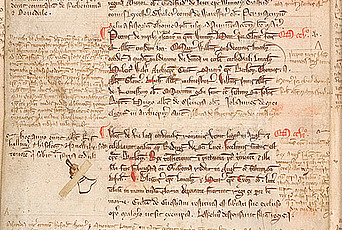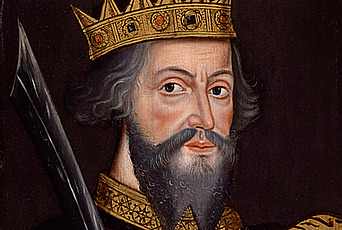The Promise and Peril of Credit

This article is a slightly edited excerpt from Francesca Trivellato's The Promise and Peril of Credit: What a Forgotten Legend about Jews and Finance Tells Us about the Making of Commercial Society. Copyright © 2019 by Princeton University Press. Reprinted by permission.
It would be misleading to say that this book “found me.” But the impetus behind it came as much from what was happening around me as from my academic interests. In September 2008, an endless stream of breaking news relayed bleaker and bleaker economic reports on the future of millions of ordinary people. Lehman Brothers collapsed. Home foreclosures became a daily event. Talk of greed resurfaced in public conversation. Even usury and usurious, words that I had not heard uttered outside of the classroom, reentered everyday vocabulary, alongside loan shark and pawnbroker. As financial mogul John Alfred Paulson admitted in April 2010, “We believed that the two-year adjustable rate mortgages made to lower income borrowers with poor credit history, little or no documentation, no downpayment and rates that would shortly reset at usurious interest rates set the stage for significant delinquencies and foreclosures, thus eroding the value of these securities."1
As a citizen, I was angry and anguished. As a historian of early modern European market organization and market culture, I was intrigued and felt slightly vindicated. Since the fall of the Berlin Wall, scholarly interest in the slow-paced economies of the preindustrial period had waned, and faith in the upward trajectory of modern financial capitalism had become nearly gospel. Now, it seemed, we were back to square one. No easy solution was in sight. In fact, the daily reports did not seem much clearer than seventeenth-century merchant manuals, which were filled with advice on how to make money as well as warnings against avarice and shady dealers.

While the global financial system stood on the brink of collapse after years of speculative frenzy, an old excerpt from Warren Buffett’s 2002 annual letter to Berkshire Hathaway shareholders resurfaced and went viral. Sounding like Cassandra amid a cheerful crowd of Wall Street investors, Buffett had described credit default swaps as “financial weapons of mass destruction” carrying “dangers that, while now latent, are potentially lethal.”2 The statement remains controversial. Not everyone agrees with Buffett’s judgment, and this skepticism affects the work of government and private agencies charged with regulating the industry to this day. What is remarkable about Buffett’s warning is that the man who offered it was not a fierce opponent of corporate finance or a future leader of the Occupy Wall Street movement, but the richest man in the world at the time of its writing.
I mention these recent events not to suggest that we can link today’s rapid “financialization” to earlier transformations of Europe’s economy in simple terms, but to point out that even those who believe in the positive effects of expanding private and public credit, now as in the past, cannot easily agree on where to draw the boundaries of that expansion and what kind of oversight might best prevent fraud and the emergence of oligopolies. The Promise and Peril of Credit examines key episodes in the West’s millennium-long struggle to delineate the place that finance ought to occupy in the social and political order. It does so by introducing readers to modes of thinking about the morality of credit that have become increasingly alien to us even as the questions that animated those early modern discussions remain as vital now as they were then.
After decades of retreat from the mainstream, economic history is making its way back to college curricula and scholarly publications. Today as always, present concerns stimulate academics’ choice of subject matter and approaches to historical inquiry. Income and wealth inequality, the connection between slavery and capitalist modes of production and consumption, the impact of cultural traditions on economic performance, and the timing and consequences of globalization top the list of current research topics pursued by economic historians of various persuasions. A sense of urgency infuses this research—a welcome and energizing change after decades during which North American history departments’ interest in economic history lay dormant. However, one should not forget that each of these themes has its own long and distinguished scholarly pedigree; nor should we risk falling into the old trap of searching for the origins of contemporary phenomena—Marc Bloch’s “idol."3 While I readily admit, and indeed embrace, the influence that present concerns exert on my scholarly work, my aim in this book is to bring back to life ways of thinking about the economy that have become increasingly foreign to the mainstream of the academy and to interrogate the sources of our amnesia about topics and problems that not long ago occupied a central place in debates about the development of European capitalism.4
In Anglophone historiography in particular, the demotion of the preindustrial period to second-rank importance in examinations of Europe’s economic takeoff has often been compounded by the enduring legacy of the Protestant Black Legend, according to which Catholic societies after the Reformation eschewed profit and indulged in idleness. This twin tendency has affected even serious scholarship and detracted from the study of economic transformations in Catholic Europe from the medieval commercial revolution to the industrial revolution. To be sure, one can always find staunch enemies of all forms of commercialization among Catholic authors, but more interesting—and, by the sixteenth century, often more influential—were those theologians, lawyers, judges, philosophers, statesmen, merchants turned writers, and polymaths who did not oppose financial dealings as such but disagreed on the written and unwritten rules that ought to govern the marketplace for the benefit of Christian and polite commercial society.
Credit was central to those intellectual debates. Derived from the Latin verb credere, “to believe” and “to trust,” the noun credit and its cognates during this period had economic, legal, political, social, and cultural connotations. Used less frequently, finance referred primarily to government finances. The more capacious and common commerce was adopted by early modern commentators not only in reference to the activities of retail and wholesale merchants, but also to describe the economic policies governing those activities. But commerce had even wider meanings that transcended the economic realm. In the Italian city-states of the fifteenth century, the Latin word commercium denoted the material transactions conducted for the purpose of earthly gain and gratification, but it was used just as often in reference to the relationship between believers and the divine, the exchange of ideas among humanists, the social bonds linking all humans (or at least those men who saw each other as peers), and even prostitution (carnal commerce). Although the word commerce had a somewhat narrower meaning by the eighteenth century, it continued to be applied to the entire gamut of human activities and beliefs. It follows that technical disquisitions about credit instruments, and what might make them go astray, were never abstracted from moral, political, and social considerations.
Thus framed, the subject of my inquiry would be boundless, since the search for a well-tempered commercial society was at the heart of too many consequential intellectual and political projects in preindustrial Europe to be examined in any depth in a single study. In this book, I turn to one little-known but revealing chapter in these heated debates about the morality of credit: a narrative that for a good 250 years, from the mid-seventeenth to the early twentieth century, attributed to medieval Jews the invention of marine insurance and bills of exchange, two key instruments of European private finance. There is no truth to this tale, since both financial tools emerged slowly out of previous arrangements, and Jews had no special role in the process, yet it proved surprisingly resilient—which is why I believe it warrants the designation of legend. Over time, this unfounded and today largely forgotten origin story punctuated many and varied literatures about commerce. By working with and around this narrative about Jews and credit, I discuss how numerous Christian authors—some famous, some fallen into oblivion—articulated their vision for a morally acceptable and productive commercial society.
I take representations of Jews’ economic roles to be symptomatic of larger claims: implicitly or explicitly, they conveyed hard-to-define ideals of a Christian-inflected marketplace rather than describing the actual involvement of Jews in the economy. This approach has been adopted almost exclusively in reference to the Middle Ages because of the widely held assumption that in the mid-seventeenth century, the “science of commerce” began to shed its religious concerns about merchants’ moral integrity.5 Here, I show instead that late medieval representations of Jews and their alleged modes of handling credit, recast in new guises at various junctions, continued to be central to the definition of European commercial society through the French Revolution and that the founders of modern social thought—Karl Marx, Max Weber, and Werner Sombart—incorporated these representations of medieval Jews’ economic roles into their grand narratives.
In the pages of this book, readers will encounter familiar names and famous moments in European history, such as those I just mentioned, but will also be introduced to a host of unknown figures and unpredictable connections across themes and periods. In trying to make sense of fragments of the past that our blind spots have led us to neglect, I weave together strains of scholarship that have been growing further and further apart. That is why this book does not fall squarely into any single field of historical inquiry but is rather an exercise in demonstrating the potential (and, no doubt, the pitfalls) of roaming across times and places, blending economic and religious history, approaching the history of economic thought from new angles, and integrating Jewish history more fully into the narrative of Europe’s past.
In piecing together the traces left by the legend that attributed to medieval Jews a foundational role in the creation of modern private finance, my ultimate aim is to demonstrate that throughout European history, debates about the market’s reach have been inseparable from the construction of legal and symbolic hierarchies of inclusion and exclusion. The impersonality of the market is a recent ideal and remains an elusive reality.
1 Financial Times, April 21, 2010, emphasis mine.
2 Buffett’s letter to his shareholders can be read in full at http://www.berkshirehathaway.com/letters/2002pdf.pdf (accessed July 9, 2018). The phrase had appeared in prominent media sources years before, but only after September 2008 did it go viral. See, e.g., “Buffet’s ‘time bomb’ goes off on Wall Street,” BBC News, September 18, 2008, http://news.bbc.co.uk/2/hi/2817995.stm (accessed July 9, 2018). The noted CBS News program 60 Minutes aired an episode entitled “Financial Weapons of Mass Destruction” on October 26, 2008.
3 Marc Bloch, The Historian’s Craft, trans. Peter Putnam (New York: Vintage Books, 1953 [1949]), 29–35.
4 Throughout the book, I purposefully avoid the casual use of the term capitalism, in spite of the new purchase it has acquired since 2008 and, especially, since the publication of Thomas Piketty’s Capital in the Twenty-first Century, trans. Arthur Goldhammer (Cambridge: Harvard University Press, 2014 [2013]). I fear that to call the money markets of premodern Europe capitalistic would interfere with my quest to identify their specificities and link them to the cultural clashes that they generated. Consequently, in referring to the economy of the late medieval and early modern periods, I often resort to the label preindustrial because structural conditions that affected the working of credit markets, notably poor information technologies and the absence of notions of legal and political equality, can be found throughout the history of Europe from 1000 to 1800. Only in the last chapter do I readily use the term capitalism, because there I engage with nineteenth- and early-twentieth-century social theories aimed at defining modern capitalism as a distinctive historical phenomenon.
5 Notable exceptions are Jonathan Karp, The Politics of Jewish Commerce: Economic Ideology and Emancipation in Europe, 1638-1848 (Cambridge: Cambridge University Press, 2008) and David Nirenberg, Anti-Judaism: The Western Tradition (New York: W.W. Norton, 2014), in particular ch. 8, which is an abridged version of Nirenberg, “Shakespeare’s Jewish Questions,” Renaissance Drama, 38 (2010): 77-113.


